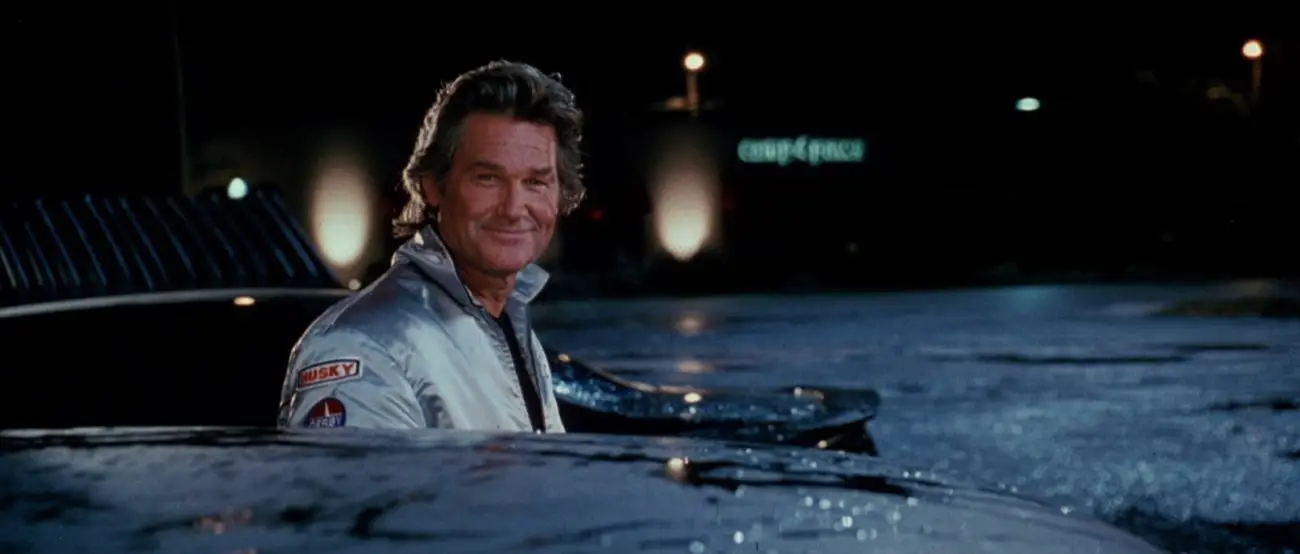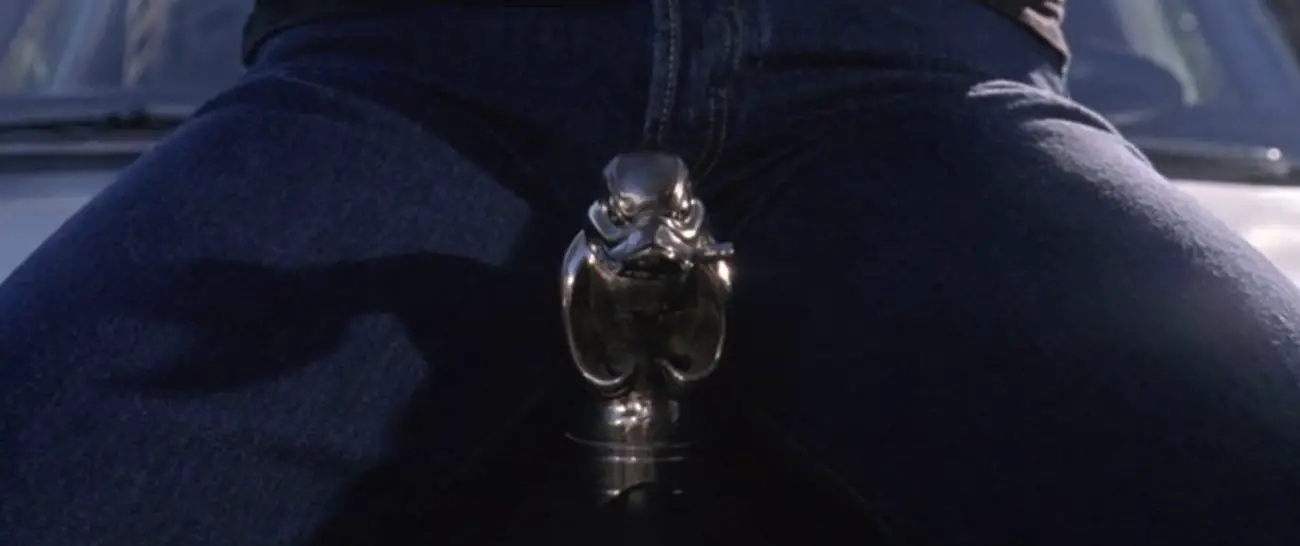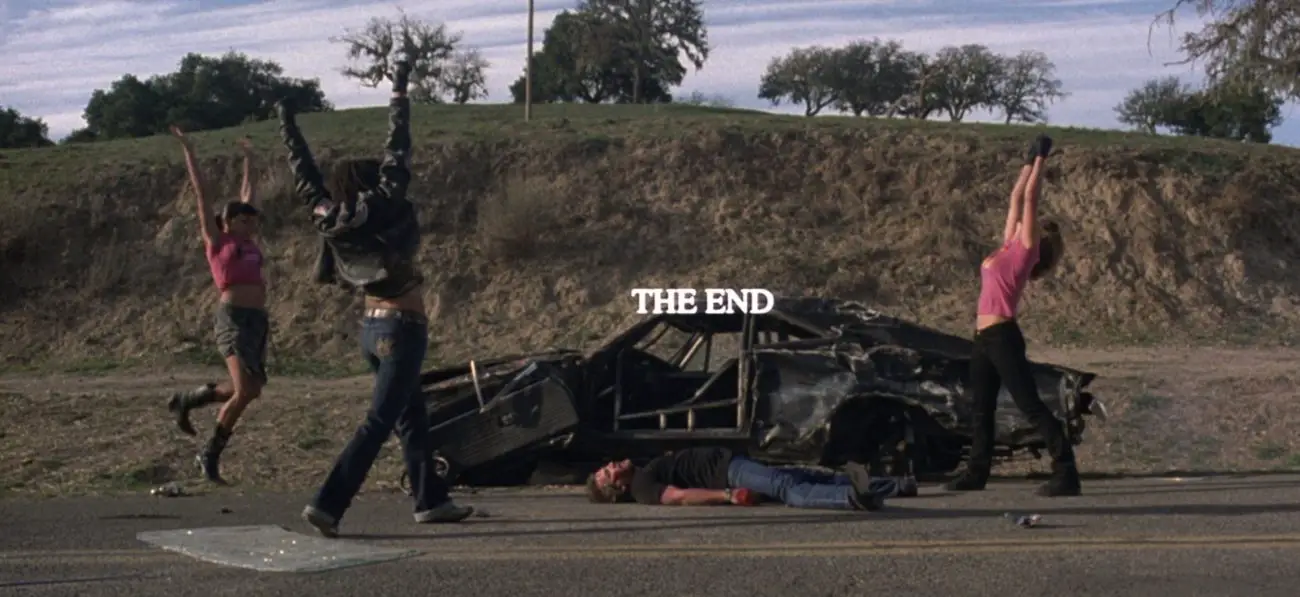“Audiences didn’t even realize how attuned they had got to contrivances of movies, because they were so used to it. So you could use that against them. You could leave the bread crumbs that would indicate you were gonna go the way all the other films had gone, then all of a sudden you make a quick left turn, and they’re not prepared for that.”
– Quentin Tarantino to Robert Rodriguez
Quentin Tarantino has made nine features (or ten, if you count the Kill Bill volumes as separate films, which you, dear reader, are more than free to do). Of those, I would say he has one truly underrated work: Death Proof. This might have to do with the film’s pacing more than anything, but I believe that is the point of Tarantino’s film. Let’s take a trip back in time.
I’m not quite sure what I was expecting when my brother and I took our seats in a sold-out auditorium on April 6, 2007, the day Grindhouse premiered in theaters. It was going to be an experience, to be sure: two films from two genre filmmakers (Tarantino and Robert Rodriguez), as well as trailers for fake movies from a few of their filmmaking friends (Rob Zombie, Edgar Wright, and Eli Roth). The order of Grindhouse is as follows:
- The trailer to Machete (Rodriguez)
- Planet Terror (Rodriguez’s movie)
- Trailers for Werewolf Women of the S.S. (Zombie), Don’t (Wright), and Thanksgiving (Roth)
- Death Proof (Tarantino)
Because it eventually bombed, both Planet Terror and Death Proof received solo releases featuring extended versions of the films, with the latter even showing at Cannes. And although, for the most part, both versions of Death Proof have the same point to make (which I’ll get to later), I believe its inclusion in Grindhouse elevates said point, which is why I’ll be focusing on that version.
Now, to say that everything from the moment the Machete trailer began to the end of the Thanksgiving trailer produced a positive response from the audience that night in April ’07 would be a massive understatement. I have since yet to experience a Friday night crowd for a just-released film like that one. There was laughter, cheers, proclamations of love toward certain actors, and just downright glee at the experience Grindhouse gave these several hundred people.

And then, Death Proof started. To say the film is a slow burn would be accurate. For the majority of Death Proof’s runtime (for the original Grindhouse version), most everyone was a lot quieter than they had been in the prior 90 minutes, with the occasional laugh or applause here and there.
I believe this to be purposeful. Tarantino wanted to lure audiences into a false sense of what the movie was before the turn that takes place approximately 80 minutes into the film.
Up until that moment, Death Proof is very much a slasher, with Kurt Russell’s Stuntman Mike using his muscle car as his weapon of choice, rather than a knife or a chainsaw. Sure, there are the Tarantino flourishes of dialogue and shots of feet (and plenty of both), but for the most part, up until that turn, Tarantino successfully creates a slow burn of a slasher movie. We meet a group of characters and then they get slaughtered. When a new group is introduced, it’s not going to be a surprise when it happens again. If anything, the anticipation this second time around makes the pace all the more suspenseful (or grueling if you just can’t take how slow the movie is).
Yes, it is slow. However, I’d argue that was exactly Tarantino’s intention. Spend over half an hour getting to know the characters and the world of Austin before giving the audience the kind of grisly deaths they want from a slasher. Then, why not spend another 30 minutes with another group? After the zombie-esque spectacle of Planet Terror and the hilarity of those trailers, well, it makes sense that this movie would be as “bad” as everything that came before it.
As such, the structure is bad, the pacing is bad, and the first payoff is just too quick (though kudos to Tarantino for giving us time to relish each death). It makes sense then that the audience would expect Stuntman Mike to kill the second group of women. When Kim (Tracie Thoms) begins driving with Zoe Bell (as herself!) on the hood of that car, with Abernathy (Rosario Dawson) in the backseat, we’re primed for Mike to show up and do his thing.
We know it’s a bit sexist. Aside from the fact that Mike targets only women, Tarantino purposely shoots the majority of the film the way films of this nature would and still typically do, with lots of lingering shots on the female characters. Even with the two creeps in the first half of the film played by Eli Roth and Michael Bacall, the audience is meant to be laughing with them, as opposed to being disgusted at the fact that they want to get the women drunk enough to have sex with them.

After a crotch-shot of Mike on the hood of his car, binoculars in hand and a smile on his face, we’re ready for what the film has promised us. These women have done nothing wrong, but according to the promise from both the genre and the film, they now must die.
Stuntman Mike shows up, begins ramming his car against theirs, and does his absolute best to scare the shit out of them. But then something happens. After both cars come to a halt, he gets out, absolutely delighted in what just occurred and, through laughs, says this:
STUNTMAN MIKE: Hey! Ladies! That was fun!
Then, Kim emerges from the car and shoots Stuntman Mike.
I was not the only person in that theater that night who was shocked. The audience collectively jumped, with a few giggles peppered throughout. A few minutes later, this exchange happened:
ZOE: You wanna go get him?
KIM: Oh, hell yeah!
There were cheers when that happened. As for Mike, we find him sobbing at the pain of his gunshot wound. He cries out, “Why?!”
And the audience laughed. We laughed so loud, it’s kind of difficult to describe. I’ve seen funny movies in a theater with an audience. It’s like a ride. Everyone feels the turns. This was more like a release. I doubt many in attendance that night knew what Tarantino was up to. He was winding up the film and us, waiting for the perfect moment to just let it all rip.
Stuntman Mike was the villain. We knew that pretty much right away from the way he looked to the musical cues. Yet, because Death Proof is a slasher, there is this weird position an audience sometimes takes where they side with the killer. It’s the reason fictional killers like Jason Vorhees and Michael Meyers are icons. The audience sort of roots for the killer, and with Kurt Russell playing Mike, it’s not difficult to do so.
The guy (both the actor and the character) is charming. The moment he slides into that John Wayne voice pretty much seals the deal. When he starts hurting Pam (Rose McGowan), the majority of the audience probably isn’t siding with her, even though we really should. I mean, what the heck did she do to deserve her fate? Heck, what did Jungle Julia and her friends do that was so wrong? Was it that they wanted a weekend with no boys?
It’s fascinating how the audience that night shifted from rooting for Stuntman Mike to rooting for these three women to hunt him down and beat his ass (to death). I mean, don’t get me wrong. It makes sense. He certainly deserved what was coming to him. It’s just for most of the film’s runtime, we followed the genre’s programming. The characters broke the rules and therefore had to be punished. Why then do we accept the turn in the film’s final minutes?
It’s because there is a turn. Rather than have the film continue down its natural path, Tarantino chose to, well, Tarantino the genre. What if this time the women not only survived but turned things around and became the killers? More than that, though, what if their new positions in the narrative were actually warranted?
As such, what is Death Proof saying? First of all, it’s great that a film that was part of Grindhouse actually has something to say. Second, it’s also great that what is said actually manages to coincide with the way the film is structured. The turn is the payoff to the slow burn of most of the film. Counting the entirety of Grindhouse, it makes sense that Death Proof would be at the end. After Planet Terror and the trailers, audiences expect one thing (a gritty genre movie), get something else (a slow burn slasher) and end up in an even more unexpected place.
If the majority of Death Proof follows the elements of the slasher genre, then the turn is the most important part, not only as a payoff to the slow burn (hence all the laughter at the unexpected) but also as a thematic critical stance. The turn involves the would be-victims turning things on the killer. The killer is a man, and the would be-victims are women. It stands to reason, then, that Tarantino wanted to say something about the slasher genre.
It could be feminist. After all, the final involves these women taking agency and becoming the heroes (of sorts) of the film. It could also be Tarantino letting audiences know that things can be different within the confines of a particular genre or sub-genre. Yes, there are rules, but rules can be bent or broken.

After all, the women do kill Stuntman Mike, so the film never becomes anything other than a slasher. It’s just that the roles become reversed. Either way, Death Proof manages the post-modern task of saying something about the very thing that it is.
Why, then, doesn’t this film get as much love as Tarantino’s other work? There could be a few reasons:
- Since its original release was a part of Grindhouse, which bombed, some probably forget it even exists.
- Again, it’s a slow burn, and even someone who loves listening to Tarantino’s dialogue could get over it pretty quickly.
- It’s a slight film. On the surface, there’s not much to it. Guy stalks women and kills them with his car. Even though we now know this to not be true, one can be forgiven for thinking it doesn’t have anything to say when putting up against, say, the two films that followed, Inglourious Basterds and Django Unchained.
- People just don’t care for it, and fair enough. No one has to like everything.
Back in 2007, when the credits rolled, there was applause. Not thunderous applause (I’ve never been in a theater where that happened), but applause nonetheless. As my brother and I left the auditorium, I could hear people talking about what they had just seen. No one mentioned Planet Terror or the trailers (that would certainly come with time). Everyone was talking about the ending to Death Proof, a movie that for most of its runtime probably bored a lot in attendance that night.
When I revisit the movie every year, it’s the end that I anticipate. I love the movie in its entirety, from the characters to the music, but the payoff remains special. Sometimes, the wait is worth it. In this case, regarding the slow burn of Quentin Tarantino’s Death Proof, the payoff is not only worth it, it’s also the entire point.




